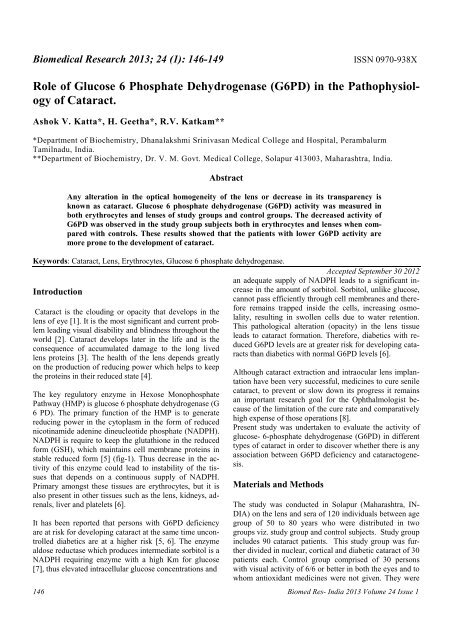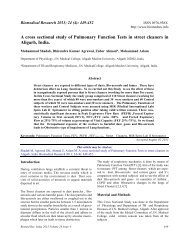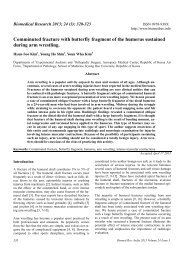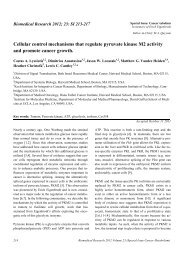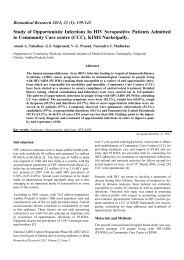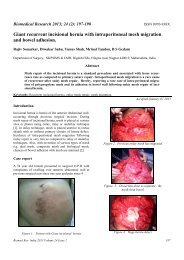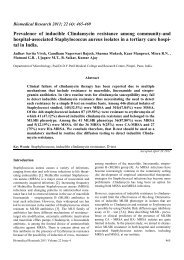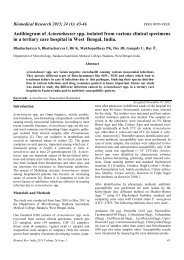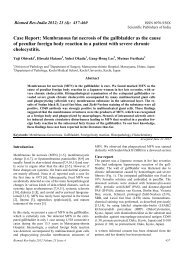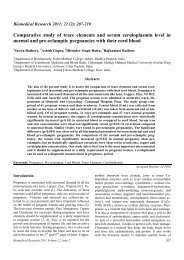Role of Glucose 6 Phosphate Dehydrogenase (G6PD) - ResearchGate
Role of Glucose 6 Phosphate Dehydrogenase (G6PD) - ResearchGate
Role of Glucose 6 Phosphate Dehydrogenase (G6PD) - ResearchGate
Create successful ePaper yourself
Turn your PDF publications into a flip-book with our unique Google optimized e-Paper software.
Biomedical Research 2013; 24 (1): 146-149 ISSN 0970-938X<br />
<strong>Role</strong> <strong>of</strong> <strong>Glucose</strong> 6 <strong>Phosphate</strong> <strong>Dehydrogenase</strong> (<strong>G6PD</strong>) in the Pathophysiology<br />
<strong>of</strong> Cataract.<br />
Ashok V. Katta*, H. Geetha*, R.V. Katkam**<br />
*Department <strong>of</strong> Biochemistry, Dhanalakshmi Srinivasan Medical College and Hospital, Perambalurm<br />
Tamilnadu, India.<br />
**Department <strong>of</strong> Biochemistry, Dr. V. M. Govt. Medical College, Solapur 413003, Maharashtra, India.<br />
Abstract<br />
Any alteration in the optical homogeneity <strong>of</strong> the lens or decrease in its transparency is<br />
known as cataract. <strong>Glucose</strong> 6 phosphate dehydrogenase (<strong>G6PD</strong>) activity was measured in<br />
both erythrocytes and lenses <strong>of</strong> study groups and control groups. The decreased activity <strong>of</strong><br />
<strong>G6PD</strong> was observed in the study group subjects both in erythrocytes and lenses when compared<br />
with controls. These results showed that the patients with lower <strong>G6PD</strong> activity are<br />
more prone to the development <strong>of</strong> cataract.<br />
Keywords: Cataract, Lens, Erythrocytes, <strong>Glucose</strong> 6 phosphate dehydrogenase.<br />
Accepted September 30 2012<br />
an adequate supply <strong>of</strong> NADPH leads to a significant increase<br />
in the amount <strong>of</strong> sorbitol. Sorbitol, unlike glucose,<br />
Introduction<br />
cannot pass efficiently through cell membranes and therefore<br />
remains trapped inside the cells, increasing osmo-<br />
Cataract is the clouding or opacity that develops in the<br />
lens <strong>of</strong> eye [1]. It is the most significant and current problem<br />
leading visual disability and blindness throughout the<br />
lality, resulting in swollen cells due to water retention.<br />
This pathological alteration (opacity) in the lens tissue<br />
world [2]. Cataract develops later in the life and is the<br />
leads to cataract formation. Therefore, diabetics with reduced<br />
<strong>G6PD</strong> levels are at greater risk for developing cata-<br />
consequence <strong>of</strong> accumulated damage to the long lived<br />
lens proteins [3]. The health <strong>of</strong> the lens depends greatly<br />
racts than diabetics with normal <strong>G6PD</strong> levels [6].<br />
on the production <strong>of</strong> reducing power which helps to keep<br />
the proteins in their reduced state [4].<br />
The key regulatory enzyme in Hexose Monophosphate<br />
Pathway (HMP) is glucose 6 phosphate dehydrogenase (G<br />
6 PD). The primary function <strong>of</strong> the HMP is to generate<br />
reducing power in the cytoplasm in the form <strong>of</strong> reduced<br />
nicotinamide adenine dineucleotide phosphate (NADPH).<br />
NADPH is require to keep the glutathione in the reduced<br />
form (GSH), which maintains cell membrane proteins in<br />
stable reduced form [5] (fig-1). Thus decrease in the activity<br />
<strong>of</strong> this enzyme could lead to instability <strong>of</strong> the tissues<br />
that depends on a continuous supply <strong>of</strong> NADPH.<br />
Primary amongst these tissues are erythrocytes, but it is<br />
also present in other tissues such as the lens, kidneys, adrenals,<br />
liver and platelets [6].<br />
It has been reported that persons with <strong>G6PD</strong> deficiency<br />
are at risk for developing cataract at the same time uncontrolled<br />
diabetics are at a higher risk [5, 6]. The enzyme<br />
aldose reductase which produces intermediate sorbitol is a<br />
NADPH requiring enzyme with a high Km for glucose<br />
[7], thus elevated intracellular glucose concentrations and<br />
Although cataract extraction and intraocular lens implantation<br />
have been very successful, medicines to cure senile<br />
cataract, to prevent or slow down its progress it remains<br />
an important research goal for the Ophthalmologist because<br />
<strong>of</strong> the limitation <strong>of</strong> the cure rate and comparatively<br />
high expense <strong>of</strong> those operations [8].<br />
Present study was undertaken to evaluate the activity <strong>of</strong><br />
glucose- 6-phosphate dehydrogenase (<strong>G6PD</strong>) in different<br />
types <strong>of</strong> cataract in order to discover whether there is any<br />
association between <strong>G6PD</strong> deficiency and cataractogenesis.<br />
Materials and Methods<br />
The study was conducted in Solapur (Maharashtra, IN-<br />
DIA) on the lens and sera <strong>of</strong> 120 individuals between age<br />
group <strong>of</strong> 50 to 80 years who were distributed in two<br />
groups viz. study group and control subjects. Study group<br />
includes 90 cataract patients. This study group was further<br />
divided in nuclear, cortical and diabetic cataract <strong>of</strong> 30<br />
patients each. Control group comprised <strong>of</strong> 30 persons<br />
with visual activity <strong>of</strong> 6/6 or better in both the eyes and to<br />
whom antioxidant medicines were not given. They were<br />
146 Biomed Res- India 2013 Volume 24 Issue 1
Katta/Geetha/Katkam<br />
all healthy individuals without any systemic diseases and<br />
without any habits like smoking, alcoholism, etc. Patients<br />
with ocular surgery, trauma, infection, inflammation <strong>of</strong><br />
the eye were also excluded from the study. Written informed<br />
consent was obtained from all subjects at the time<br />
<strong>of</strong> recruitment into the study. Institutional ethical committee<br />
approval was taken for the present study.<br />
Collection <strong>of</strong> lenses and preparation <strong>of</strong> homogenate<br />
The cataractous lenses were removed surgically by<br />
PECCE+IOL (Planned extra capsular cataract extraction+<br />
intraocular lens) technique. The lenses were obtained and<br />
packed in ice-cold saline and immediately taken to the<br />
laboratory. Each lens was weighed and its wet weight<br />
(mg) recorded. The lenses were homogenized with a Teflon<br />
rod and diluted to 1:10 (w/v) by adding 50mM potassium<br />
phosphate buffer (2mM EDTA), P H 7.00. The lens<br />
homogenates obtained were centrifuged at 10,000 rpm for<br />
15 min at 4 0 C. The supernatants obtained following centrifugation<br />
were processed for estimation <strong>of</strong> the <strong>G6PD</strong><br />
activity by Kornmethodberg and Horecker method [10].<br />
Blood collection<br />
The 2ml blood sample was collected by venipuncture<br />
from the patients undergoing surgery for cataract on the<br />
same day. blood was collected in a EDTA bulb for the<br />
assessment <strong>of</strong> <strong>G6PD</strong> activity.<br />
Statistical Analysis<br />
All results were expressed in mean ± SD. One way<br />
Analysis <strong>of</strong> Variance (ANOVA) was used to test the<br />
significance <strong>of</strong> difference and student "t" test to test<br />
significance <strong>of</strong> difference between two groups. A p-<br />
value < 0.05 was considered as statistically significant.<br />
Results and Discussion<br />
Table I represents the comparisons <strong>of</strong> mean activities<br />
<strong>of</strong> <strong>Glucose</strong>-6- <strong>Phosphate</strong> dehydrogenase in RBCs and<br />
Lenses in deferent type <strong>of</strong> Cataracts. There was<br />
significant decrease (p
Katta/Geetha/Katkam<br />
Figure 2. Schematic diagram showing mechanism <strong>of</strong> cataract formation and events in reduced activity <strong>of</strong> glucose 6<br />
phosphate dehydrogenase<br />
There are conflicting reports in the literature regarding<br />
the role <strong>of</strong> <strong>G6PD</strong> deficiency in the development<br />
<strong>of</strong> cataract. Various researchers suggested that in<br />
cataract high molecular weight proteins are formed<br />
following extensive oxidation which causes precipitation<br />
<strong>of</strong> lens proteins and thereby causing loss <strong>of</strong><br />
transparency [7].<br />
The pathogenesis <strong>of</strong> the cataract in an early age individuals<br />
with <strong>G6PD</strong> deficiency might be shows that<br />
the enzyme plays an important role in the lens metabolism.<br />
Deficiency <strong>of</strong> <strong>G6PD</strong> affects HMP Shunt in<br />
the lens that leads to shortening <strong>of</strong> ribose availability<br />
for the synthesis <strong>of</strong> nucleic acid and decreases the<br />
renewal <strong>of</strong> lens proteins. Also decreases the synthesis<br />
<strong>of</strong> NADPH which is necessary to convert oxidized<br />
glutathione to reduced glutathione causes low<br />
levels <strong>of</strong> reduced glutathione. This might increased<br />
susceptibility <strong>of</strong> the lens to oxidative insult and subsequently<br />
leads to oxidation <strong>of</strong> lens proteins and precipitation<br />
<strong>of</strong> lens proteins loss <strong>of</strong> lens transparency<br />
[11,12, 13] (Fig. 2).<br />
References<br />
1. Katta AV, Suryakar AN, Katkam RV, Shaikh AK, Ghodake<br />
SR. Glycation <strong>of</strong> lens crystalline protein in the pathogenesis<br />
<strong>of</strong> various forms <strong>of</strong> cataract. Biomedical Research<br />
2009; 20 (2): 119-121.<br />
2. Bunce GE, Kinoshita J, Horwitz J. Nutritional factors in<br />
cataract. Annu Rev Nutr 1990; 10: 233- 254.<br />
3. Zehra Hashim and Shamshad Zarina. Antioxidant markers<br />
in human senile and diabetic cataractous lenses.<br />
JCPSP 2006; 16 (10): 637-640.<br />
4. Halliwell B. Antioxidants: the basic what they are and<br />
how to evaluate them. Adv Pharmacol 1997; 38: 3-19.<br />
5. Marjorie FL Redox regulation in the lens. Prog Retin<br />
Eye Res 2003; 22; 657-82.<br />
6. Babizhayer MA, Deyer AL, Chemikov AV. Peroxide<br />
metabolizing system <strong>of</strong> crystalline lens. Biochem Biophys<br />
Acta 1992; 16: 1-9.<br />
7. Crabbe M, Goode D. Aldose reductase: a window to the<br />
treatment <strong>of</strong> diabetic complications Prog Retin Eye Res<br />
1998; 17: 313-383.<br />
8. Sun W, Zhang X, Zhang S, Zhou Z. oxidative damage<br />
and enzyme histochemistry changes in the senile cataract.<br />
U. S. Chinese Journal <strong>of</strong> Ophthalmology 2001;<br />
1(1): 1-3.<br />
9. Orkide D, Yorulmaz EO, Pekel H, Suyugul N. Blood<br />
and lens lipid peroxidation and antioxidant status in<br />
normal individuals, senile and diabetic cataractous patients.<br />
Cur. Eye Res. 2002; 25(1): 9-16.<br />
10. Kornberg & Horecker. Determination <strong>of</strong> activity <strong>of</strong> <strong>Glucose</strong><br />
6-phosphate dehydrogenase by rate <strong>of</strong> reaction method.<br />
Method in Enzymology 1955; 1: 323-324.<br />
11. Meloni T, Karala J, Forteleoni G, et al. <strong>Glucose</strong> 6 phosphate<br />
dehydrogenase deficiency and cataract <strong>of</strong> patients<br />
in northern Sadinia. Am J Opthalmol 1990; 110: 661-4.<br />
12. Orzalesi N, Sorcinelli R, Guiso G. Incrased incidences<br />
<strong>of</strong> cataract im male subjects deficient in <strong>G6PD</strong>. Arch.<br />
Ophthalmol. 1981; 99: 69-70.<br />
Biomed Res- India 2013 Volume 24 Issue 1
Katta/Geetha/Katkam<br />
13. Chandrasena LG, Silva LDR De, Silva KI De, Dissanayaka<br />
P, Peiris H. Change in Erythocyte <strong>Glucose</strong> 6<br />
phosphate dehydrogenase deficiency (<strong>G6PD</strong>) and reduced<br />
glutathione (GSH) activities in development <strong>of</strong><br />
senile and diabetic cataracts. Southast Asian J Trop Med<br />
Public Health 2008; 39 (4): 731-736.<br />
14. Moro F, Gorgone G, Li Volti S et. al. <strong>Glucose</strong> 6 phosphate<br />
dehydrogenase deficiency and incidences <strong>of</strong> cataract<br />
in Sicily. Ophthalmic Paediatr Genet. 1985; 5 (3):<br />
197-200.<br />
15. Bhatia RP, Petel R, Dubey B. Senile cataract and <strong>Glucose</strong><br />
6 phosphate dehydrogenase deficiency in Indians.<br />
Trop Geogr Med. 1990; 42 (4): 349- 351.<br />
16. Yuregir G, Varinali I, Donma O. <strong>Glucose</strong> 6 phosphate<br />
dehydrogenase deficiency both in red blood cells and<br />
lenses <strong>of</strong> normal and cataractous native populations <strong>of</strong><br />
Cukurova, the southern part <strong>of</strong> Turkey. Part I. Ophthalmic<br />
Res. 1989; 21(3): 155-157.<br />
17. Balaji M, Sasikala K. Sundararajulu G, Ravindran T,<br />
Sathar ML. Analysis <strong>of</strong> <strong>Glucose</strong> 6 phosphate dehydrogenase<br />
deficiency in anterior subcapsular and mixed cataractous<br />
lenses. Br J Ohthalmol. 1995; 79: 1124-1125.<br />
Correspondence to:<br />
Ashok V. Katta<br />
Department <strong>of</strong> Biochemistry<br />
Dhanalakshmi Srinivasan Medical College and<br />
Hospital, Perambalur (Tamilnadu)<br />
India..<br />
Biomed Res- India 2013 Volume 24 Issue 1


